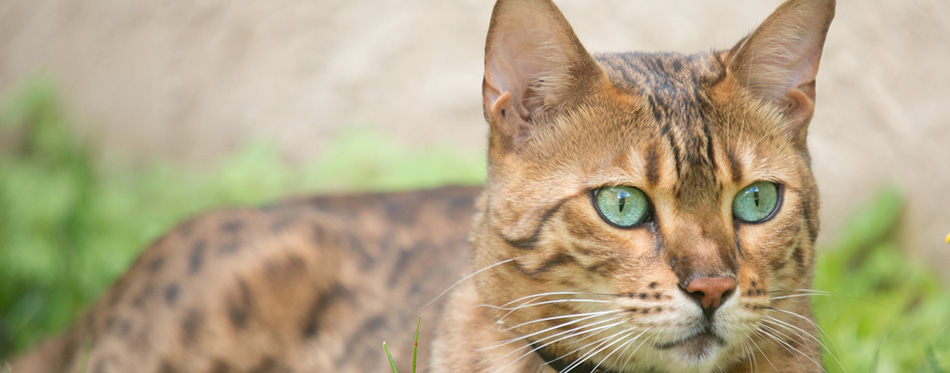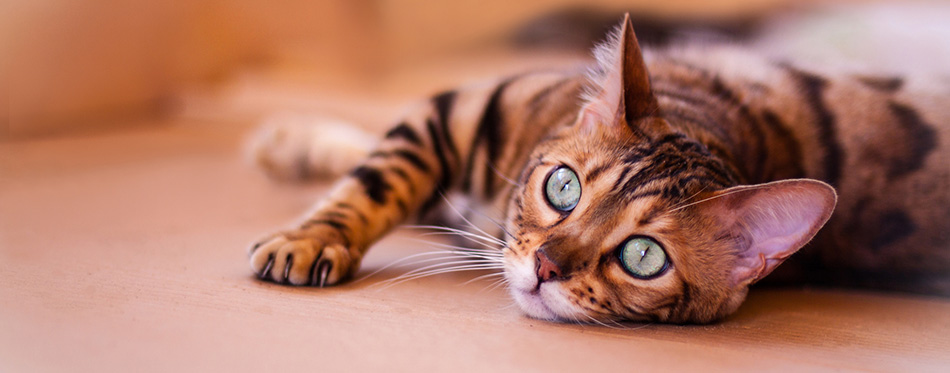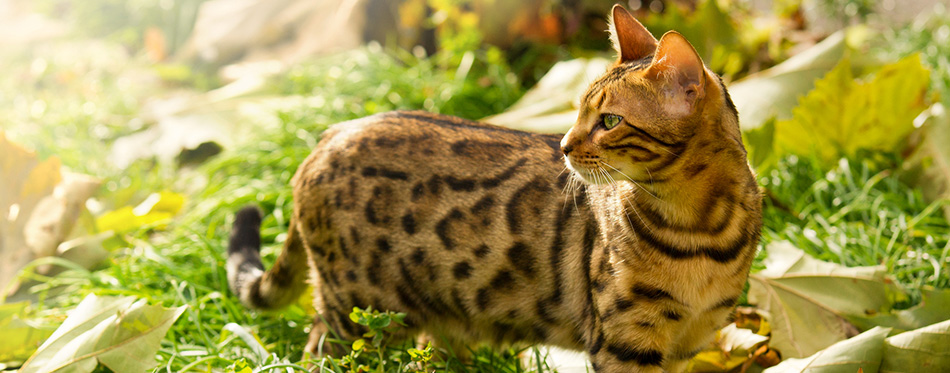The Bengal cat is a feline pet that is best reserved for people who like to bring home something more exotic than the usual run-of-the-mill domestic cat. This kitty has the coat color patterns of two of the largest cats in the wild: the tiger and the leopard. The best part of the Bengal is that it may have the look of a wild kitty but its character and temperament is that of a sociable, friendly, affectionate, and adaptable dog. In other words, the Bengal cat is a kitty that should do well with a pet-loving family. Pamper it with affection and love and it will return the favor many times over. Train it well and the Bengal will provide you with endless entertainment for everyone to see. But before you get a Bengal for your family, it is best to learn everything you can about this lovely breed.

History of the Bengal Cat
Most folks who see the Bengal cat for the first time think that it is a product of genetic manipulation. There is an ongoing belief that the Bengal is the result of miniaturizing the Bengal tiger because of the classic black stripes. But the Bengal also has black spots which make it a miniaturized leopard. The truth is that the Bengal is neither a mini tiger nor a mini leopard. Instead, it is a mixture of the Asian leopard cat and an ordinary domestic cat.
The Prionailurus bengalensis bengalensis is a leopard-looking wild cat that is native to East, South, and Southeast Asia. It is not a variety of leopard, however, since the latter is a member of the Panthera genus of large, carnivorous cats. On the other hand, the Bengalensis is no larger than a domestic cat. As such, when people in South Asia began crossbreeding the Bengalensis bengalensis with a domestic cat, they were already producing what the world would later know as the Bengal cat.
The reason for the crossbreeding is quite simple. Breeders wanted a cat that had the look of a formidable jungle creature. They also wanted to retain the confident temperament, health, and friendliness of the domestic cat.
It is not known when the actual hybridization took place. There are conflicting reports saying it began sometime in the last quarter of the 19th century with the publication of Harrison Weir’s “Our Cats and All About Them” in 1889. C. Boden Kloss disputed this claim in 1927, arguing that there were no crossbreeds of cats in the Malayas during this period. However, Kloss did mention about tribeswomen nursing young Bengalensis cats. The issue is that Kloss couldn’t be sure, too, if these Bengalensis cats were ever crossed with domestic kitties.
In 1934, a Belgian scientific journal confirmed the crossbreeding between a domestic cat and a wild Bengalensis. The literature did not say, however, when the first hybridization occurred or who facilitated the crossbreeding. Nevertheless, it is sufficient to know that the Bengal cat is the result of mixing a wild cat with a domestic feline.
Sometime in the 1940s, Jean Mill brought home a Bengalensis cat to become her black tom cat’s companion. The pair mated and produced kittens with black spots. Mill retained one of the female kittens and bred it back with the kitten’s father. The breeding resulted in kittens in either solid colors or spotted coat patterns. The kittens became the subject of Mill’s genetics term paper at the University of California, Davis.
In the 1970s, Willard Centerwall hoped to produce a cat that showed immunity against feline leukemia, a disease that is very common among domestic cats. Learning about the remarkable attributes of the Bengalensis, Centerwall sought to crossbreed it with domestic cats. Unfortunately, Centerwall was not able to pursue his dreams because of a serious illness.
It was Jean Mill who continued Centerwall’s work. She included a brown spotted tabby and an orange shorthair in the hybridization program. Mill believed that only a selective breeding program can help ensure the many fine qualities of the Bengal cat.
In 1983, the International Cat Association gave conditional recognition to the Bengal cat as one of the experimental cat breeds at the time. It would take another 8 years before the breed gained full recognition from the ICA.
Quick Facts about the Bengal Cat
The Bengal cat may be the result of crossbreeding but it sure is now one of the most-loved kitties in the world. In 2018, the Cat Fanciers’ Association ranked the Bengal cat as its 16th most popular feline breed. It bested the Russian blue, Burmese, Siberian, Ragamuffin, and Birman cats, among others. Dog-loving pet parents also love the Bengal because of its canine-like sociability, friendliness, activity levels, and intelligence. Here are several other interesting facts that all potential pet parents of the Bengal have to know about the breed.
- Bengal kitties are a lot similar to the domestic cat when it comes to size and weight. It can weigh 8 lbs at the very minimum and tops at 15 lbs. There are some Bengals that can weigh more than 15 lbs, of course, but this is already on the obese side of things.
- Asian leopard cats lead long lives in the wild. This is a trait that the Bengal was also able to inherit, capable of reaching up to 16 years.
- Bengals have a wedge-shaped head. It looks like the head of a Siamese, but with more rounded edges.
- It has a muscular body; something that the Bengal needs to fuel its athletic abilities.
- This cat has a dense coat, complete with silky soft fur.
- Its coat can come in various colors like seal silver lynx point, black silver tabby, seal mink tabby, and brown tabby.
- There are three coat patterns on the Bengal. Most will have tiger-like stripes while others can sport leopard-like spots. There are also those that come with a combination of stripes and spots. There are also Bengals that come with marbled coat pattern.
- This is a low-shedding feline. However, this is never a reason for not brushing it on a regular basis.
- The Bengal’s limbs are medium in length. Its hind legs are longer than its front legs, though.
- Bengal cats have high energy levels, requiring exercise and extended play time.
- This cat is a friendly feline, both towards children and dogs.
- Some cat fanciers call the Bengal as the Rolls Royce of all companion cats. This stemmed from one particular story whereby a British woman bought a Bengal for $50,000. The year was 1990. If you were to buy this cat today, it would cost you $93,772.
- On the average, a Bengal cat can sell anywhere between $400 and $10,000. Everything depends on the breeder, the quality of the cat, the location, and the gender of the kitty.

Things You Should Know
The Bengal cat is an exotic feline that has many characteristics that are dog-like. Having said that, it is not surprising to learn that hardcore dog-lovers also fall in love with this feline breed. It is affectionate and has the curiosity of little explorers. It is an adaptable cat that is easy to groom. Most of all, this is a kitty that will play with your children all day long, every single day during the school break. Aside from the fact that this breed can command a hefty price tag, there are a few other things you ought to know. It is imperative that you learn more about the breed before you finalize your decision to get one.
Health
One of the reasons why the Bengalensis became one of the founding stock for the creation of the Bengal is to eliminate the threat of feline leukemia. While you may not see this condition from the Bengal cat, it does not confer automatic immunity to other feline diseases. Like all products of hybridization, there is a chance that the diseases of one parent will crop up in any of the kittens.
The Bengal, like all cats, is at risk of the development of hypertrophic cardiomyopathy. This is a type of heart disease whereby a certain section of the heart grows very thick. This has a negative impact on the heart’s ability to pump blood. In such cases, oxygen delivery gets compromised, resulting in ischemia in various organs. Hypertrophic cardiomyopathy can be devastating to the Bengal because of its high levels of energy. It may not be able to meet its metabolic demands.
One thing you have to understand about this feline disease is that it is a recessive trait. What this means is that the actual disease will manifest every other generation of the breed. For instance, if the Bengal cat does not have the disease now, at least one of its kittens will have it. If the kitten grows and becomes a mother cat itself, it will produce kittens that do not have the disease. When this kitten (3rd generation) produces its own kittens, at least one of them will have hypertrophic cardiomyopathy.
Bengal cats are also susceptible to eye problems like progressive retinal atrophy and cataract formation. The management of cataracts in cats often involves surgery. Unfortunately, surgery is not ideal for Bengal cats because of hypersensitivity to anesthetic agents.
Other diseases that the Bengal cat may present with include luxating patella, distal neuropathy, flat-chested kitten syndrome, and hip dysplasia.
Aspiring owners of Bengal cats should always ask for health certifications from their breeders. If possible, the health certification should include DNA or genetic testing of disease markers. While such tests do not include all possible feline diseases, they do provide information on the more common ones.
Feeding
Bengals lead a very active lifestyle. They are lively Yorkshire Terriers in a domestic cat’s body. That being said, these cats need the right amounts of calories for their energy needs. While carbohydrates provide instant energy for the Bengal, it should not comprise more than 40 percent of its diet. If not, you are courting feline obesity.
There is one fundamental reason why Bengal pet parents are cautious about the amount of calories that their kitties receive. We learned in the preceding section that Bengals are prone to luxating patellas. This condition can lead to degenerative arthritis and worsened by feline obesity. As such, pet parents should never overfeed a Bengal as this can worsen the degeneration of the joint apparatus.
High-quality raw foods remain the ideal diet for Bengals. The issue with raw foods is that they can be difficult to source. There aren’t many sellers of raw whole prey cat food. As an alternative, some pet parents will cook meals for their own Bengal cats. The advantage of this is that you can choose the ingredients to use. You can also avoid those ingredients that can be toxic or harmful to cats. The problem with this method is that it can be challenging to determine the nutrient analysis of the cat food. Hence, you will never know if you are giving the right amounts of nutrients to the Bengal.
A good alternative is wet cat food. Whenever looking for a canned cat food, it is imperative that you read the ingredient list and the guaranteed analysis. The first ingredient on the list should always be a named animal protein. It should never be plant-based protein. Taurine is an amino acid that is present only in animal proteins, not in plant proteins. The Bengal kitten needs this amino acid for optimum development of its nervous and cardiovascular systems.
For more guides on choosing the right cat food, you may wish to check out our reviews of the best senior cat food, hypoallergenic cat food, cat food for hairballs, kitten food for your cat and cat food for bengals.

Care
Pet parents of the Bengal have this to say about the breed: it behaves more like a dog. Bengals are intelligent and have an insatiable curiosity. They also have high energy levels that require more constructive outlets. Hence, one of the fundamental requirements in caring for the Bengal is to give it plenty of exercise. It does not have to be several hours in the pet gym. Extended play time is already enough.
This kitty loves learning tricks. Caring for it means giving it a lot of stimulating things to do. Training it or teaching it different tricks can help promote its mental and behavioral health. One has to remember that this breed is a very active cat. If you don’t give it something to do, then it will look for something else to while its time. This means it will never hesitate to scratch your furniture and other stuff.
Bengals love the water. It is a good idea to create a swimming pool for them to dip into. But if you already have a pool in your backyard, that would work, too. The point here, of course, is to be always mindful of the Bengal’s safety in the water. Make sure to supervise every activity that it has.
This exotic kitty also needs cat trees. It loves to climb and leap from one elevated platform to the next. Most pet parents build a dedicated playground for their Bengal cats. These are enclosures that can mimic the environment upon which the Asian leopard cat thrived in.
Litter boxes require frequent cleaning. No cat wants to use a smelly toilet. If you have one Bengal at home, then get at least two litter boxes to provide the cat with an alternative.
Always keep the Bengal cat indoors. This is a very expensive cat that you do not want to fall in the hands of the wrong people. Plus, there are way too many dangers outdoors.
Grooming
Grooming the Bengal is easy. This is despite the fact that it has a dense coat. Everyday brushing of its coat is ideal; although once every 3 to 4 days is sufficient. Bathing is not necessary, unless you’ve got a dirty Bengal on hand. Cleaning the ears is mandatory every 2 weeks. Cleaning the eyes is also important and this can be done once a week. Bengals also need every day dental care. If this is impractical, then once every 3 days is enough.
For more help on cat grooming, you may wish to read our guides on the best cat ear cleaners, cat nail clippers, brushes for cats, cat grooming gloves and cat shampoos.
Temperament
The Bengal is a dog in a feline frame. It has a friendly nature that makes it an adorable companion to cat-friendly canines. It is active, playful, and very curious. It loves being with the children of its human family. Bengals love to perform and entertain their family. They like learning new things so they have something to add to their repertoire of tricks.
Bengals love the attention that they receive from the people they love. If they feel you are not giving them the kind of love that they expect, they will let you know. This is a smart kitty and it knows how to get your attention. It does not matter if it is going to be the destructive kind of attention-seeking behavior. As long as it gets you to notice it, then the Bengal will do it.
Bengal cats are one of the world’s most adorable felines. It is not because of their wild, exotic look, but more because of their uncanny temperament or characteristics. This is perfect for folks who may want a dog that meows as well as people who can devote plenty of time to the Bengal.

